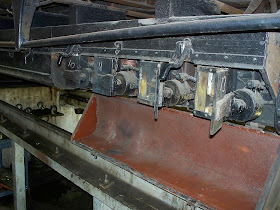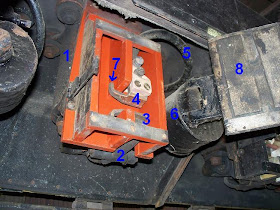 Today was the first day of public operation for the two-car blue train this year; the train was made up last night and both cars operated successfully for five trips today with Jim Nauer operating and myself as conductor. The day was not without incident, though. The 308 had some issues with a finicky triple valve that did not always release when a light brake application was taken (there were no problems with heavier applications). Other than a few hard stops there were no real issues, but this will be addressed. Fortunately we currently have a functional spare M3A triple on hand and will probably swap this in until the problems with the triple valve on the car can be fixed.
Today was the first day of public operation for the two-car blue train this year; the train was made up last night and both cars operated successfully for five trips today with Jim Nauer operating and myself as conductor. The day was not without incident, though. The 308 had some issues with a finicky triple valve that did not always release when a light brake application was taken (there were no problems with heavier applications). Other than a few hard stops there were no real issues, but this will be addressed. Fortunately we currently have a functional spare M3A triple on hand and will probably swap this in until the problems with the triple valve on the car can be fixed.
The other issue was that one of the springs on the 308's #2 end trolley base broke, as shown at right. This didn't affect operations at all; since the two-car train is bused together we simply used the poles on the 309 all day. This should be a straightforward and, hopefully, fairly simple fix.
After the end of operations I changed into work clothes and went over to Barn 4, where Joel Ahrendt, Joe Stupar and Stan Wdowikowski, with help from Dan Mulvihill, were working on reassembling rebuilt components for North Shore 757's type DH-25 air compressor. I mostly just sat around and watched (and took photos) though I did lend a hand for a few minutes.


 Shown here, L-R: Joel and Stan tighten down the crankshaft; Joe, Joel and Stan working on lining up the reconditioned armature (foreground); and Joe replaces the top cover after installation of the field coil assembly (foreground, around the armature).
Shown here, L-R: Joel and Stan tighten down the crankshaft; Joe, Joel and Stan working on lining up the reconditioned armature (foreground); and Joe replaces the top cover after installation of the field coil assembly (foreground, around the armature).












































